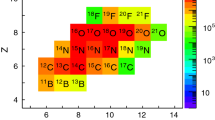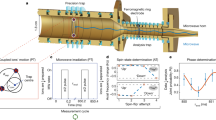Abstract
Magnetic moment measurements of picosecond states generally make use of the huge transient magnetic fields which fast nuclei experience during their passage through a ferromagnetic foil. Based on the Recoil Distance Transient Field (RDTF) method previously pioneered by the Göttingen group, we propose the Doppler Shift Transient Field (DSTF) method to measure g-factors of short-lived high-spin states excited in a heavy ion fusion reaction at a high recoil velocity. This method can be used whenever the state is populated by fast discrete feeder transitions γ2. By measuring the Larmor precession of the decay γ-ray γ1 with a gate set on the Doppler shifted tail of γ2, one selects events of high recoil velocity (= high transient field) and avoids, to a large extent, the uncertainties of delayed side and cascade feedings inherent in heavy-ion fusion reactions. Estimates are given for the DSTF precessions in 102Cd and 74Br.
Similar content being viewed by others
References
Bodenstedt, E., In: W. D. Hamilton (ed.) The Electromagnetic Interaction in Nuclear Spectroscopy, North-Holland, Amsterdam, 1975, p. 737.
Sprouse, G. D., In: Hyperfine Interactions in Excited Nuclei, Gordon and Breach, New York, London, Paris, 1971, p. 931.
Stuchberry, A. E., Anderssen, S. S. and Bezakova, E., Hyp. Interact. 97/98 (1996), 479.
Jungclaus, A., Hyp. Interact. 120/121 (1999), 107.
Lieb, K. P., In: D. N. Poenaru and W. Greiner (eds), Experimental Techniques in Nuclear Physics, de Gruyter, Berlin, New York, 1997, p. 425.
Dewald, A., Harrisopulos, S. and von Brentano, P., Z. Phys. A 334 (1989), 163; Petkov, P. et al., Nucl. Instr. Meth. A 431 (1999), 208.
Brandolini, F. and Ribas, R. V., Nucl. Instr. Meth. A 417 (1998), 150.
Böhm, G. et al., Nucl. Instr. Meth. A 329 (1993), 248; Petkov, P. et al., Nucl. Instr. Meth. A 437 (1999), 274.
Jungclaus, A. et al., Phys. Rev. Lett. 80 (1998), 2793.
Teich, C., Jungclaus, A. and Lieb, K. P., Nucl. Instr. Meth. A 418 (1998), 365.
Teich, C. et al., Phys. Rev. C 59 (1999), 1943.
Alber, D. et al., Z. Phys. A 344 (1992), 1.
Persson, J. et al., Nucl. Phys. A 627 (1997), 101.
Kownacki, J. et al., Nucl. Phys. A 627 (1997), 239.
Lieb, K. P. et al., Phys. Rev. C 63 (2001), 054304.
Müller, G. A. et al., Phys. Rev. C 64 (2001), 014305.
Johnstone, I. P., private communication.
Biersack, J. P. and Ziegler, J. F., program TRIM95, unpublished.
Programs LINESHAPE and DECHIST, Wells, J. C. et al., ORNL Physics Division Progress Report 30, 1991, Nr. ORNL-66B9.
Speidel, K. H., private communication.
Jacob, G. et al., Z. Phys. D 32 (1994), 7.
Loritz, R. et al., Eur. Phys. J. A 6 (1999), 257.
Lieb, K. P., Progr. Part. Nucl. Phys. 46 (2001), 205.
Author information
Authors and Affiliations
Rights and permissions
About this article
Cite this article
Lieb, KP., Galindo-Leon, E. & Dhar, S. Magnetic Moment Measurement of Short Lived States via the Doppler Shift Transient Field Method. Hyperfine Interactions 136, 215–223 (2001). https://doi.org/10.1023/A:1020536400474
Issue Date:
DOI: https://doi.org/10.1023/A:1020536400474




